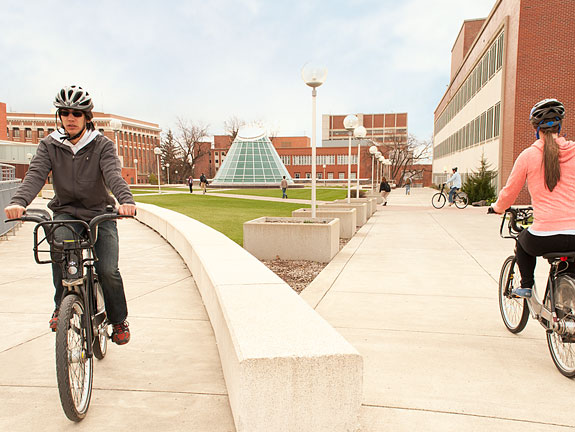One fuzzy old photograph of construction in downtown Pullman shows images of early days in the city: men laying a foundation by hand, a horse-drawn carriage on the street, a bicycle leaning on a post in the foreground. The photo has no date, but that bike, like a relic dropped by a time traveler, looks remarkably modern.
You won’t see a horse-drawn anything on Pullman’s streets now, except in parades, but you still see bikes among the buses, pedestrians, and a lot of cars.

Bridgette Brady, director of Washington State University’s Transportation and Parking Services, envisions bike use on campus increasing over the next decade and sees a need to plan for it. In that vein, WSU hosted a bike forum last year with transportation expert Mia Birk, former manager of the City of Portland’s bicycle program and author of Joyride: Pedaling Toward a Healthier Planet. In her visit with local and university leaders, bike riders, and others, Birk praised Pullman’s trail system, but pointed out areas for improvement. Among them: “Stadium Way is very challenging,” says Brady. “And we only have one or two bike lanes on campus.”
So it is time for a change, says Brady. “We want to help students, faculty, and staff avoid the high cost of operating single-occupancy vehicles,” she says. “We also want to support WSU’s sustainability initiatives through reducing WSU’s carbon footprint.”
She would like more connections for bicyclists farther away from central campus, including perhaps a transit center combined with a parking garage. A center could house some of the BIXI Green Bikes from the WSU bike share program that are popping up all over campus. The lightweight gray metal bikes are currently parked in seven locations around WSU, as well as ridden around Pullman and out on the Chipman Trail to Moscow.
The bikes are for students and university employees, who can use their Cougar card to unlock a bike and borrow it for up to 24 hours at no cost. Some long-term bikes are also available for up to seven days.
BIXI operates shared bike programs around the world, but WSU is the first university to use the bikes, according to Jamie Bentley, coordinator of the year-old program through University Recreation. The program has become extremely popular, says Bentley. “We’ve had about 6,000 users and 16,000 rides in the last year. Students love them.”
As an extra benefit, “students get out of their cars to use something that also gives them physical activity and gets them more connected with their surroundings,” she says.
Green bikes aren’t the only new sight around campus. Crimson-colored cougar-themed buses now prowl the hills and streets of Pullman, giving more than 1.5 million rides per year to students, faculty, Pullman residents, and visitors. Pullman Transit has operated the bus system—along with a popular Dial-a-Ride service—since 1979. Now the buses have a new look and new, lower emissions.
According to Pullman Transit manager Rod Thornton, the system is one of the most efficient in the country. “Most transit systems run 20, 25, or maybe 30 passengers an hour per bus. We average, year-round, 60 passengers an hour. You get on the expresses, you’re looking at 100-110 passengers an hour,” he says. Students, faculty, and staff ride for free, as do visitors on football game days.
The bus system in Pullman has always been successful. “People said when we started, if we had 1,000 riders a day that would be good. We did that the first day,” says Thornton, who was Pullman Transit’s first employee.
The next generation will be even more efficient, with cleaner diesel hybrid engines.
Bikes and buses are just part of the story. Students sometimes need to travel farther. For that they can borrow a Zipcar. WSU signed a contract in August 2011 with the well-established car-sharing service. Students and others can pay a $25 annual fee and hourly costs to use a vehicle.
One Zipcar can take five single-occupancy vehicles off the road, another benefit for WSU’s sustainability initiative, says Brady.
Of course, many students still have cars, but often use an even older form of efficient transportation: sharing rides. With a new system at WSU called Zimride, ride-sharing has entered the era of social networks. Students sign up, fill out a profile, and post or search for rides. They can select riders or rides based on cost, destination, or even musical taste.
As many students and former students know, sharing a ride can lead to some lasting memories and serendipitous occasions. One Zimrider from WSU caught a ride to the airport with Ethan, a University of Idaho student who told her a story about a backpacking trip with friends in north Idaho. They ran out of food and, while hitchhiking back to their cars, were picked up by an older gentleman and his nephew. The Zimrider smiled and said that offer of a ride sounded like something her grandfather would do.
Well, “It was my Grandpa and my cousin. Ethan and his friends went back to our cabin for dinner and met my whole family,” she says. “You should have heard my Grandpa when I called to tell him who I had on the line waiting for him.”
